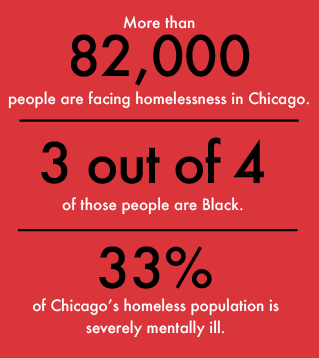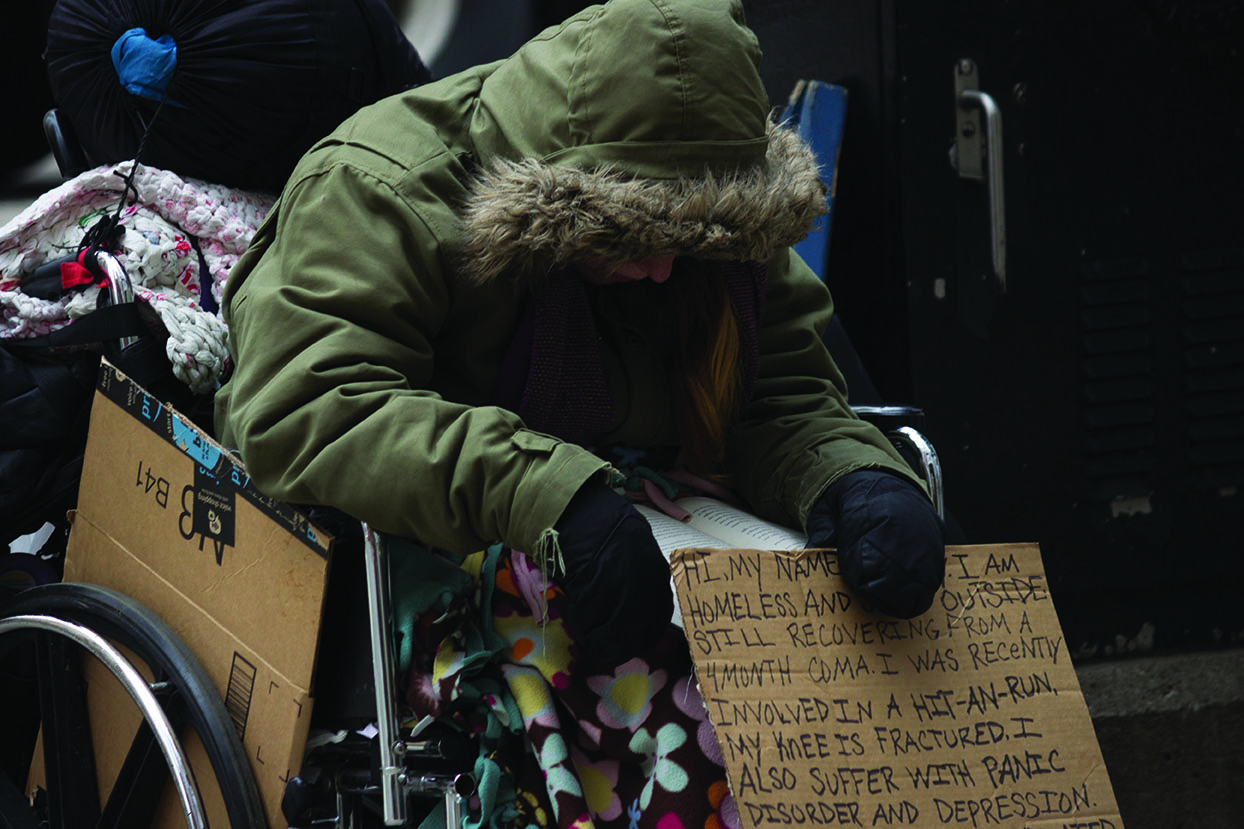Of the more than 80,000 people homeless on the streets of Chicago, most are either mentally ill, people of color or military veterans. Worried advocates are warning that recent cuts in services put nearly all of them at further risk.
Although three of four homeless people in Chicago are Black and a third deal with some sort of mental illness, according to the Chicago Coalition for the Homeless (CCH), their needs are distinctive, given that they also are young and old, educated and uneducated, men, women and children.
Massive reductions in state spending have left tens of thousands without needed treatment and medication, while efforts to provide housing are only now coming to fruition.
Exacerbating the problem is what many mental health professionals are calling a “state of emergency” in the Illinois prison system — there are 10 times more mentally ill people in jails and prisons in the United States than in mental health hospitals, according to the Cook County Sheriff’s office.
Add it all up, and the stresses on the homeless population keep increasing, despite determined efforts to address the main reasons why so many people are displaced.
One of the biggest factors contributing to Chicago’s homelessness is a lack of mental health treatment. In 2016, Illinois’ largest provider of social services, Lutheran Social Services of Illinois, closed over 30 of its programs and laid off 750 of its staff, according the National Alliance on Mental Illness. The closure was a result of the budget impasse Illinois faced for over two years.
Also in 2016, one of the largest mental health service providers, Community Counseling Centers of Chicago, closed due to Gov. Bruce Rauner’s $82 million cut in mental health program funding, which left 10,000 patients at a loss for treatment.
However, one treatment center hasn’t closed, and that’s the Cook County Jail — one of the largest mental health facilities in the United States. Jails and prisons now serve as the largest mental health providers in 44 of the 50 states, according to a statement from Cook County Sheriff Thomas Dart.
“Through benign neglect and disastrous public policies, state and local governments have apparently decided over the past few decades that it is perfectly acceptable for our jails to serve as warehouses for the mentally ill,” Dart said in the statement.
A majority of the media attention has been focused on larger jails, but studies have shown that individuals with mental illnesses are responsible for the rise in incarceration rates in smaller counties and jails, as well, according to the statement.
These large populations of mentally ill people are causing an emergency situation for treatment, and advocates are calling it a “human rights disaster.”

In October 2016, a number of lawyers representing 12,000 mentally ill prisoners in Illinois asked Judge Michael Mihm to force the state to meet its obligation to provide necessary mental health care, according to court documents. Attorneys from three legal organizations — Equip for Equality, Uptown People’s Law Center and Dentons — said there is a backlog of more than 3,000 inmates who need to see a psychiatrist, which is causing problems for treatment.
Dr. Pablo Stewart, a psychiatric consultant and the court monitor in this case, expressed his concern about the Illinois Department of Correction’s (IDOC) “grossly insufficient and extremely poor quality of psychiatric services,” in his report for court documents related to a May 2016 settlement of a class action lawsiuit on behalf of 11,000 mentally ill inmates who had to wait to see a doctor.
“The overall quality of the psychiatric services provided to the mentally ill offenders of IDOC is often times dangerous,” Stewart wrote. “The lack and quality of psychiatric services negatively impacts all aspects of the settlement and contributes to IDOC being non-compliant in the vast majority of areas of the settlement.”
Stewart also said the IDOC needs to take immediate action and pick a new director of psychiatric services to hire new staff, fire the old staff and rework the psychiatric programs they’re using.
Michelle Kamin-Lindsay, a bond court social worker for the Cook County Department of Corrections, is responsible for conducting mental health assessments for those charged with felonies and waiting to have a bond court hearing. She addresses mental and physical health and substance abuse issues with the accused, but she said her assessments don’t have any influence on the decision in a bond hearing.
If Kamin-Lindsay does identify a need for treatment, she said part of her job is to refer the accused to the necessary programs. The referrals can also be to places such as shelters if the accused is homeless.
“I’ve heard people say, ‘I turned myself in because I didn’t know what else to do,’ or ‘I was here yesterday, I got bonded out. But I’m committing what I call crimes of survival, and here I know I at least can get the care that I need,’” Kamin-Lindsay said.
A large portion of the homeless she deals with choose to be homeless or get arrested because it’s better than most of Chicago’s shelters, citing that bed bugs have been an immense problem.
In an effort to get more homeless people off the streets and out of jail, the City Council passed the Shared Housing Ordinance in June 2016 that mandated a 4 percent surcharge be added to home share service companies such as Airbnb. As of June 2017, the rental taxes have racked up $2.8 million in funds for the homeless, $1 million more than estimated, according to the Chicago Business Journal.
Plans to use the funds through a program called Housing Homeless Families, a joint initiative with the CCH and its HomeWorks Campaign, were announced in a press release from Mayor Rahm Emanuel.
The communities seeing the highest rates of violence assoiated with homelessness include Austin, Humboldt Park, West Englewood, and Englewood.
Although Chicago residents may not see the logic of spending money to provide convicted inmates with mental illness care because it’s costing taxpayers money. The more homeless and mentally ill people convicted and sentenced, the higher the jail population, which is why Illinois is one of the top 15 states when it comes to cost per prisoner.
It would cost the state less to send someone to college than it costs to house a prisoner. Each prisoner costs about $34,000 to house annually, while the average in-state, four-year private college tuition in Illinois costs about $28,000 per year.
Around 70 percent of Illinois inmates are in prison for non-violent crimes. When non-violent offenders are jailed instead of given supervised release, they’re more likely to commit new crimes when they’re released, according to the John Howard Association of Illinois (JHA). This perpetuates the cycle of cost per prisoner, overcrowding and unstable treatment conditions for the homeless and mentally ill.



